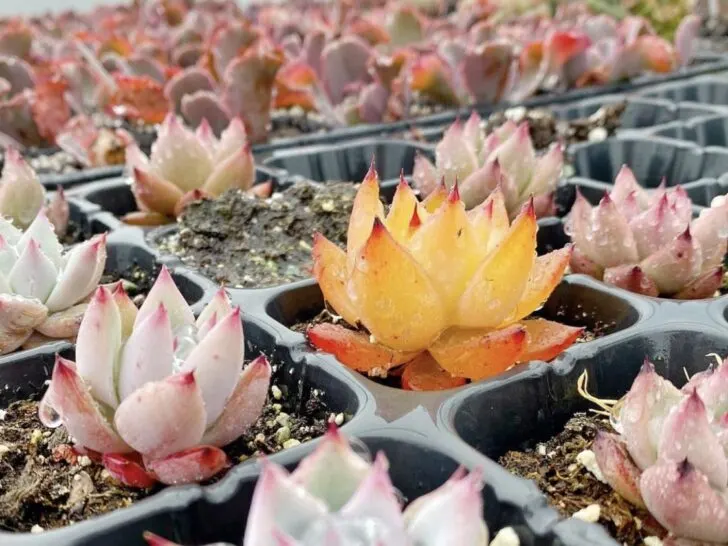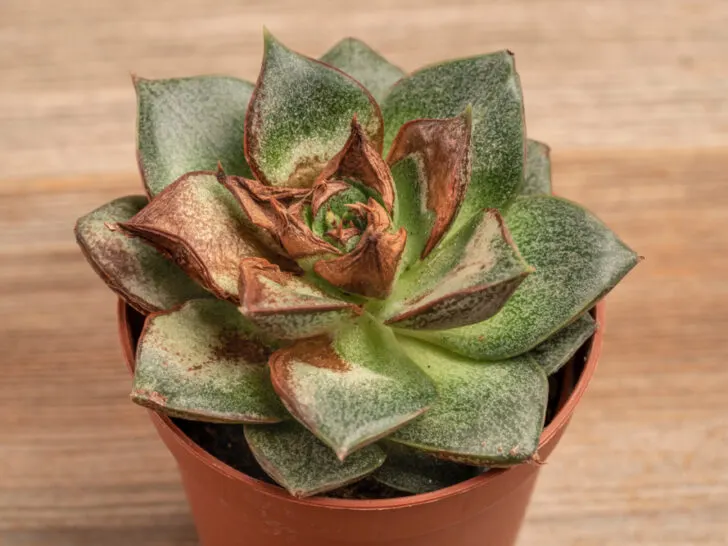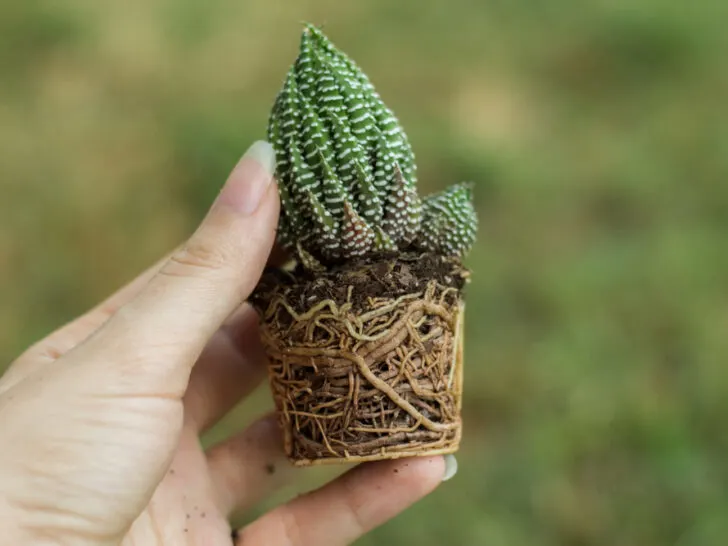
Succulent leaves sometimes turn black, brown, or yellow, when they don’t receive adequate care. Like any other plant, they’re vulnerable to various issues that require different means to address.
Succulent leaves can turn black, brown, or yellow due to overwatering, sunburn, and leaf rot. Succulents require less frequent watering than many plants, and too much water can damage their roots and leaves. They’re also vulnerable to leaf damage due to too much direct sunlight and pest attacks.
In this article, I will explain the different causes of succulent leaves turning yellow, brown, or black, how to solve these problems, and how to avoid them in the future.
1. Overwatering Discolors Succulent Leaves

Succulents come in a variety of colors. Many have green leaves, but they can also be shades of red, blue, and purple. However, if your succulent is suddenly turning from its usual coloration to yellow, brown, or black, there is likely an underlying problem.
Yellow leaves are commonly caused by too much water. Some leaves may also have brown or black spots that appear water-soaked.
In addition to the discoloration, your succulent leaves will probably be soft and spongy. At first, you may only find one or two leaves changing colors. Your plant will likely be fine and won’t have much lasting damage.
If most or all of your succulent leaves are changing colors, you should take action as soon as possible.
How to Fix Overwatered Succulents
Overwatering is a relatively simple problem to solve. You can start by cutting back on how often and how much water you give your succulent. To reduce the amount of moisture your succulent is taking in, you can move it from its current planter to one with fresh, dry soil.
Water Your Succulents Sparingly
On average, a succulent should be watered every seven to ten days. The best way to tell when your succulent needs water is by how dry the soil is. If it is dry to the touch about an inch (2.54 cm) deep, give it enough water to moisten the soil.
Use a Succulent Mix with Good Drainage
It’s essential to have the proper soil for your succulents to thrive and stay healthy.
Unlike other flowers and household plants, regular potting soil is not the best medium to keep succulents in. Store-bought potting soil contains a large number of organic materials that allow it to retain moisture.
Too much water can be harmful to succulents and their root system. You want to use soil that is loose and allows for excess moisture to drain to the bottom of the pot.
Mixing sand or perlite into regular potting soil is an excellent way to promote drainage. You can also place a small layer of gravel or rocks at the bottom of the pot for the excess water to collect.
Alternatively, choose an unglazed terracotta pot with drainage holes at the bottom. The holes will drain the excess water away from the roots. The material is also breathable, facilitating quicker evaporation.
You should be careful if you try and transfer your succulents from the pot and soil they came in into a new planter. Succulents’ root systems are delicate and can be easily damaged when moving. The change in soil may also stunt their growth.
2. Underwatering Turns Succulent Leaves Yellow or Brown

Succulents thrive in dry climates, such as deserts. They can sustain themselves over long periods of drought because their leaves retain a lot of moisture. While they don’t need to be watered every day, this doesn’t mean you shouldn’t be watering your succulents at all.
Although you want to avoid giving a succulent too much water, remember that insufficient water can lead them to suffer from dehydration.
Brown leaves can be the result of either overwatering or underwatering. The difference is that underwatering will result in wrinkly succulent leaves that turn brown and appear dry.
Some of the leaves on your succulent may also fall off due to underwatering. This is normal and not necessarily a sign that your plant is beyond saving.
How to Fix Underwatered Succulents
This is very simple to fix, as you only need to give your succulents more water. You may see your succulent bounce back after some time. Be patient and let the plant slowly gain back its lost moisture.
As well as falling off naturally, your succulent can benefit from having dead or dying leaves cut off. This way, they won’t be directing water and nutrients to parts of the plant that don’t require them.
3. Fungal Diseases Can Result in Discolored Leaves

Soil pathogens, such as fungi, can thrive in consistently moist soil. In large enough populations, they can cause severe damage to the roots, leading to root rot. Other fungi species can thrive on the surface of succulent leaves, discoloring them.
Root Rot
Succulents with severe fungal infections in the roots will likely die without intervention.
Although it’s hard to recognize root rot in the early stages, you’ll know that the issue has progressed when the leaves start to appear paler than usual or turn yellow. In some cases, the leaves might even appear brown or black.
Mildew
Succulents are best suited for dry, arid climates. As such, too much water will cause their leaves and roots to become damp and soggy.
Mildew can build up when there is excess moisture. The succulent leaves will then eventually turn yellow as the disease progresses.
Gray Mold
A gray mold infection is identifiable by the grayish-brown discoloration of the leaves. This disease is caused by Botrytis cinerea and usually affects unhealthy plants.
Succulents are most vulnerable to this type of infection during the cooler, more temperate months of spring or summer.
How to Fix Fungal Disease
If your succulent is experiencing root rot, you should transfer it to a new pot and add clean soil as soon as possible. You should also remove any rotten leaves and roots to avoid further damage. If done soon enough, your succulent can make a comeback.
However, succulents infected by other fungal diseases are unlikely to survive. The best you can do is to remove any healthy leaves or stem cuttings and transplant them.
You can also search for healthy offsets if your succulents produce them. You can grow them in a new pot with a fresh succulent mix.
After identifying the fungi species, you can also apply a suitable fungicide on your new plants. That will help prevent the reoccurrence of the infection.
4. Pest Attacks Create Black Spots on Succulent Leaves

Black leaves can be caused by rotting roots. Rot can be the result of overwatering as well as pests and diseases.
There are many insects that feast on succulents, including mealy bugs, aphids, mites, and slugs. Each type of pest will result in slightly different forms of damage to your succulent.
Mealybugs
Mealybugs are a variety of insects that can infest different parts of succulents. Some bugs feed on and attack the roots. Others focus on the leaves and outer parts of the plant.
By feeding on the plant, mealy bugs suck away vital nutrients. These bugs can also contribute to various fungal infections in succulents because they serve as disease vectors.
The damage to leaves and roots encourages rot and mold to spread throughout the succulent.
Aphids
Aphids are easily identifiable by their bright green exteriors. Similar to mealy bugs, they feed on exposed parts of succulents.
In addition to attacking roots or leaves, aphids also often attack the flowers of cacti and other succulents. Aphid-infested leaves typically turn yellow over time.
Mites
There are several varieties of mites. One of the most common types of mites you will find on succulents is red spider mites. They’re not spiders but do leave a silky residue reminiscent of a spider’s web. Damage from spider mites can lead to dry, brown leaves.
Slugs
Slugs are common garden pests. They often target vegetables and fruits. They thrive outdoors and you’re unlikely to find them on your indoor succulents.
They can chew on the leaves of your low-growing outdoor succulents. The bitten parts will eventually dry up and turn brown.
Slugs, as well as snails, reproduce very quickly and at a very high rate, so you may find yourself dealing with a large infestation and even more damage to your plants.
How to Fix Pest Attacks
To avoid bugs and pests from eating your plants, make sure to keep your succulents in a clean area and keep the windows closed.
Plant-safe bug sprays can also help deter insects from getting too close. In the case of aphids, you can introduce ladybugs to your garden. These ladybugs feed on aphids and make for excellent biological control.
On the other hand, you can manually remove slugs from your garden. You can spread coarse sand around your succulents. Slugs dislike it because they can get injured.
5. Too Much Sun Can Burn Succulent Leaves

Black and brown leaves can be a sign of more severe damage to your succulent. They can be caused by the same issues mentioned above.
They can also occur due to sun damage. This can happen if your succulent is planted outside or if it receives hot and bright sunlight next to an unobstructed glass window.
The longer a succulent is exposed to sunlight, the more water it will absorb to keep itself hydrated. Once that water is gone, the succulent’s leaves are left vulnerable to the sun’s intense UV rays.
How to Fix Sunburn
Simply moving your planter away from windows can remedy this. Most succulents do best when receiving bright but indirect sunlight.
There are many types of succulents found in nature. However, if you purchase your succulents from the gardening section of a store, they’re likely bred to be sustained indoors.
When kept indoors, you can control and regulate how much water or sunlight the succulent receives. This is opposed to planting them outdoors, where sudden rain or a particularly hot day can affect their growth.
6. Your Succulent Is Root-Bound

Many succulents are small and slow-growing so they can remain in small jars or pots for several years. However, their root systems still need enough space to expand and grow.
When they’re confined in a very small space, succulents can suffer from being root-bound. This can result in a succulent having difficulty maintaining moisture and nutrients, stunted growth, and leaves growing mushy and dark in color.
How to Fix Root Bound Succulents
Repotting a root-bound succulent is the best and easiest way to counter the negative effects. A larger vessel will give the roots more space to spread and absorb the necessary water and nutrients.
The new pot you move the succulent to should be at least an inch (2.5 cm) wider in diameter than the old one. The new pot should also have fresh, healthy soil and proper drainage to prevent a build-up of excess water.
Some of the roots may be excessively damaged and need to be removed. Use a sterilized knife or pair of scissors to remove the dead roots. This will allow the healthy roots to absorb water and reduce waste.
Conclusion
Succulents are resilient, versatile houseplants. They’re great for beginners and relatively easy to maintain in a small indoor space. However, it’s easy to accidentally overwater a succulent or expose it to too much sunlight. Rot and pests can also cause severe damage.
Your succulent leaves may start to turn colors due to these various issues. Yellow leaves are a sign of overwatering. Brown leaves are a sign of underwatering. Black leaves are a sign of overwatering, sun damage, or leaf rot.
As long as you keep them adequately watered and potted, your succulents will stay green and healthy!
Other Articles You May Also Be Interested In
How To Prune Succulents | A Guide For You

